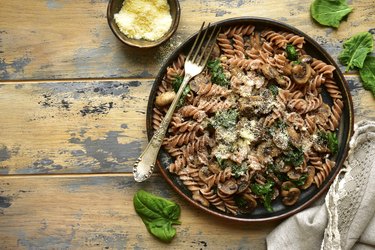
A hard, dense wheat with a high protein content, durum wheat is the variety most often used to make pasta, from spaghetti to ziti. After milling, the endosperm is ground into semolina, which is mixed with water to make pasta dough.
Durum wheat is also used to make the grain-like pasta called couscous. Pasta is often demonized for its effects on blood sugar, but it's low to medium on the glycemic index. If you eat too much, however, the effects are amplified.
Video of the Day
Video of the Day
Tip
White durum wheat spaghetti has a GI of 44, which makes it a low-glycemic food; couscous has a GI of 61, qualifying it as a medium-glycemic food.
What Is Glycemic Index?
The glycemic index is a system used to asses the impact of a food on blood sugar and insulin. Only foods containing carbohydrates, such as vegetables, fruits, grains and grain products, are given a GI score, because carbohydrates are the macronutrient that affects blood sugar the most.
The higher a food's rating, the more it affects blood sugar. Using the GI index can help you choose foods and snacks that keep your blood sugar stable, which can prevent dips in energy, mood swings, irritability and other undesirable effects.
Durum Wheat's Glycemic Index
Foods are classified as low-, medium- and high-glycemic based on their GI scores. A food with a score of 55 or less is considered low glycemic, a score of 56 to 69 is considered medium and a score of 70 or more is considered high.
White durum wheat spaghetti has a GI of 44, which makes it a low-glycemic food; couscous has a GI of 61, qualifying it as a medium-glycemic food.
Consider Glycemic Load
A standard serving size of durum wheat pasta or couscous is 1/2 cup, but people often eat way more than that. Think about the pasta portions you're served in restaurants. This is why glycemic index may not be the most accurate measure of a food's effect on blood sugar — because it doesn't take into account serving size.
Another measurement, called glycemic load, combines GI and the total carbohydrate into a single, more accurate number. A 1 1/4-cup serving of white flour pasta — a more realistic restaurant portion — has a GL over 20, which makes it a high-glycemic-load food.
Healthy Pasta Tips
Pasta can be a healthy part of your diet as long as you watch your portion size. Whole-grain pastas have a lower glycemic index than refined pastas because they have a higher fiber content and are digested more slowly. Look for the words "whole wheat" in the ingredient list of the pasta you choose.
When cooking durum wheat pasta or couscous, keep in mind that longer cooking times raise the glycemic index. Cook pasta to "al dente," which means firm to the bite. Test the pasta as it nears the recommended cooking time. When pasta is cooked al dente, you will feel some resistance when you bite or cut it.
- Wheat Foods Council: "Types of Wheat Flour"
- Joy Bauer: "Refined Grains - How Food Affects Health"
- University of Illinois: "What Impacts Blood Glucose Levels?"
- University of Sydney: "GI Database"
- Academy of Nutrition and Dietetics: "What Is Glycemic Index?"
- Clinical Diabetes: "The 3 R's of Glycemic Index - Recommendations, Research and the Real World"
- Harvard School of Public Health: "Carbohydrates"